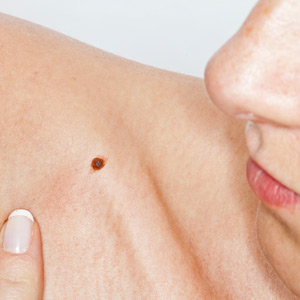Mole & Wart Removal
CryoPen® is a state-of-the-art method using extreme cold to safely destroy unwanted moles, warts, skin tags, keloids and resistant hyperpigmentation.
CryoPen® uses no chemicals or scalpels it safely, effectively and comfortably removes warts, moles, skin tags, keloids, presquamous cell carcinoma and other skin lesions. Removal is comfortable with little to no scarring.
How is the CryoPen® better than other methods of removing skin lesions?
It requires no anesthesia, has less scarring, with minimal post-op care than other techniques of skin lesion removal.
What are the series of events after the CryoPen® procedure?
During the procedure the area freezes and turns white. After the white area thaws, a flushing occurs that turns the area red. This thawing is associated with a pinching sensation or a dull ache as a wheal is formed. This wheal will develop into a water blister that will usually rupture within 24-48 hours and within 3-5 days the area will begin to form a scab. The scab will fall off in approximately 1-2 weeks. Depending on the extent of the freeze a new scab may reform and the process will repeat itself. The lesion will be completely healed in 2-6 weeks. After primary healing occurs the area may be whiter than the surrounding tissue, usually this repigments over time.
[/two_third][one_third_last] [/one_third_last]
[/one_third_last]
How long does a single freeze take?
Freeze time varies depending on the type of lesion. A typical freeze time is between 5 seconds for small flat warts to 120 seconds for a full thickness malignant lesion. For general purposes most lesions take about 30-60 seconds.
CryoPen® Advantages
- No contact with dangerous cryogenic gases or liquids
- Immediate treatment without referral
- Low risk procedure
- Simple, safe, effective treatment with little discomfort
Skin Cancers: What to Look For
The three most common skin cancers are: basal cell carcinoma, squamous cell carcinoma, and malignant melanoma. Because each has many different appearances, it is important to know the early warning signs. Look especially for change of any kind.
The Warning Signs
A skin growth that increases in size and appears pearly, translucent, tan, brown, black, or multicolored.
A mole, birthmark, beauty mark, or any brown spot that:
- Changes color
- Increases in size or thickness
- Changes in texture
- Is irregular in outline
- Is bigger than 6mm, the size of a pencil eraser
- Appears after age 21
- A spot or sore that continues to itch, hurt, crust, scab, erode, or bleed.
- An open sore that does not heal within three weeks
Actinic keratoses, also called solar keratoses, are caused by the sun, and occur on body areas that have been exposed to sunlight. These growths are more common among pale-skinned, fair-haired, light-eyed individuals. They are flatter, redder, and rougher than seborrheic keratoses. Actinic keratoses are pre-cancerous, which means they may become cancerous. Any raised, reddish, rough textured growth should be examined by your physician.
Do not ignore a suspicious spot simply because it does not hurt. Skin cancer might be painless, but dangerous all the same. If you notice one or more of the warning signs, see your physician right away.
Tips for Sun Protection
- Use sunscreen with an SPF of at least 15 on all exposed skin, including lips, even on cloudy days
- Re-apply sunscreen frequently
- Plan outdoor activities early or late. Avoid peak sunlight hours between 10am and 4pm
- More Skin Care Tips
Courtesy of: The Skin Cancer Foundation, New York, NY (www.skincancer.org)
Possible Side Effects and Risks of Mole Removal
- A blister or scabbing can form up to 48 hours after treatment. An antibiotic cream or ointment can be used. Other short term effects include bruising, superficial crusting, and discomfort. 100% Aloe and Lavender oil may be applied for discomfort, scabbing and/or pigmentation issues.
- Hyperpigmentation (browning) and hypopigmentation (lightening) can occur with some people. These conditions usually resolve within 2-12 months. Permanent color change is a rare risk but is possible. Vigilant care must be taken to avoid sun exposure (tanning beds included) before and after the treatments to reduce the risk of color change. Sun block (with zinc) must be applied when sun exposure is necessary to protected pigmented area. Lavender oil may be applied for pigmentations, Vi C serums, microdermabrasion and chemical peels to the area will all stimulate repigmentation. There is no guarantee that the area will fully repigment. However for most individuals it does if the skin is not exposed to tanning elements, recommendations are followed in a timely manner and 12 months has passed.
- Infection is not usual after treatment. Should any kind of infection occur, your regular treating doctor must be notified to prescribe appropriate medical care.
- Follow up care is available to me to help stimulate re-pigmentation if necessary.
PLEASE NOTE THERE ARE POSSIBLE RISK FACTORS ASSOCIATED WITH THE FDA APPROVED CRYOPEN. WHEN YOU MAKE YOUR APPOINTMENT YOU CONSENT TO TREATMENT AND THE RISKS INVOLVED WITH IT.
[divider style=”1″ align=”center” size=”normal” variant=”normal” dimension=”1px” color=”#D30056″ scrolltext=””]Policies[/divider]
Please extend the courtesy of calling to cancel at least 24 hours in advance. Appointments that are cancelled with less than 24 hours notice will be subject to a cancellation fee. All sales are final on products and services.
Payment in full is due at the time services are rendered.


